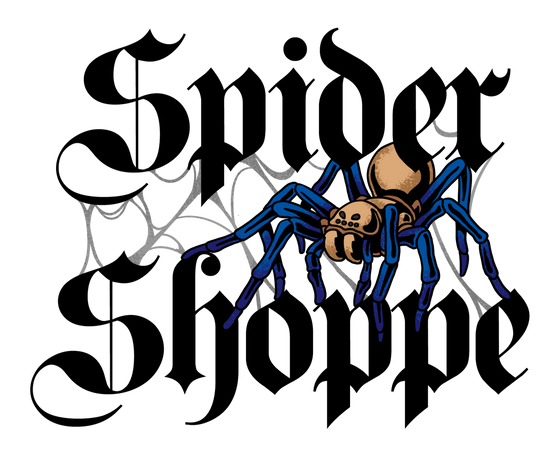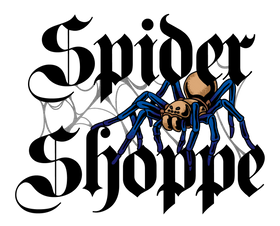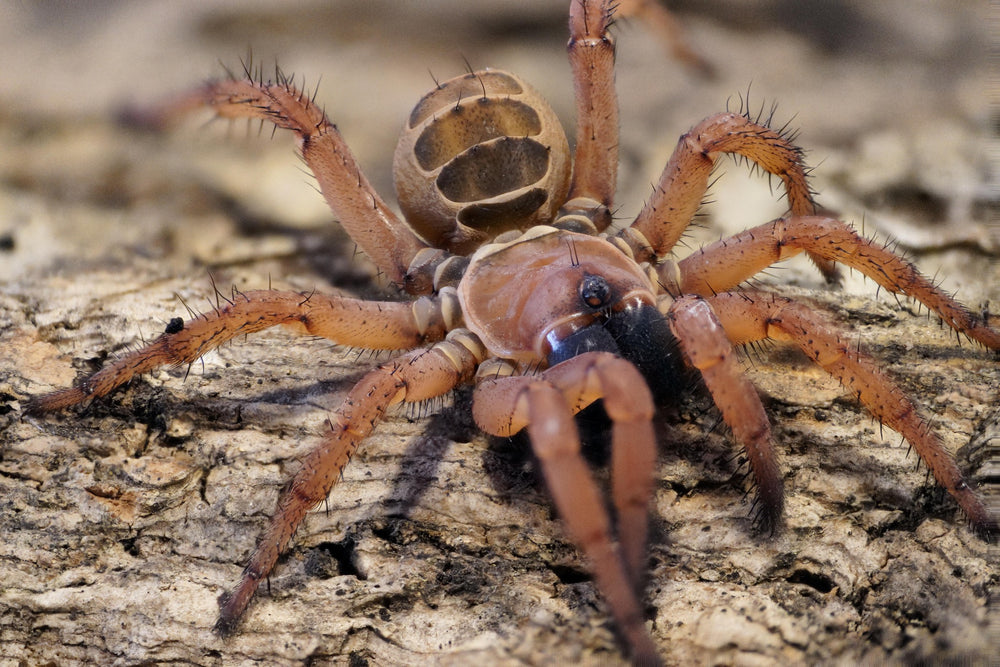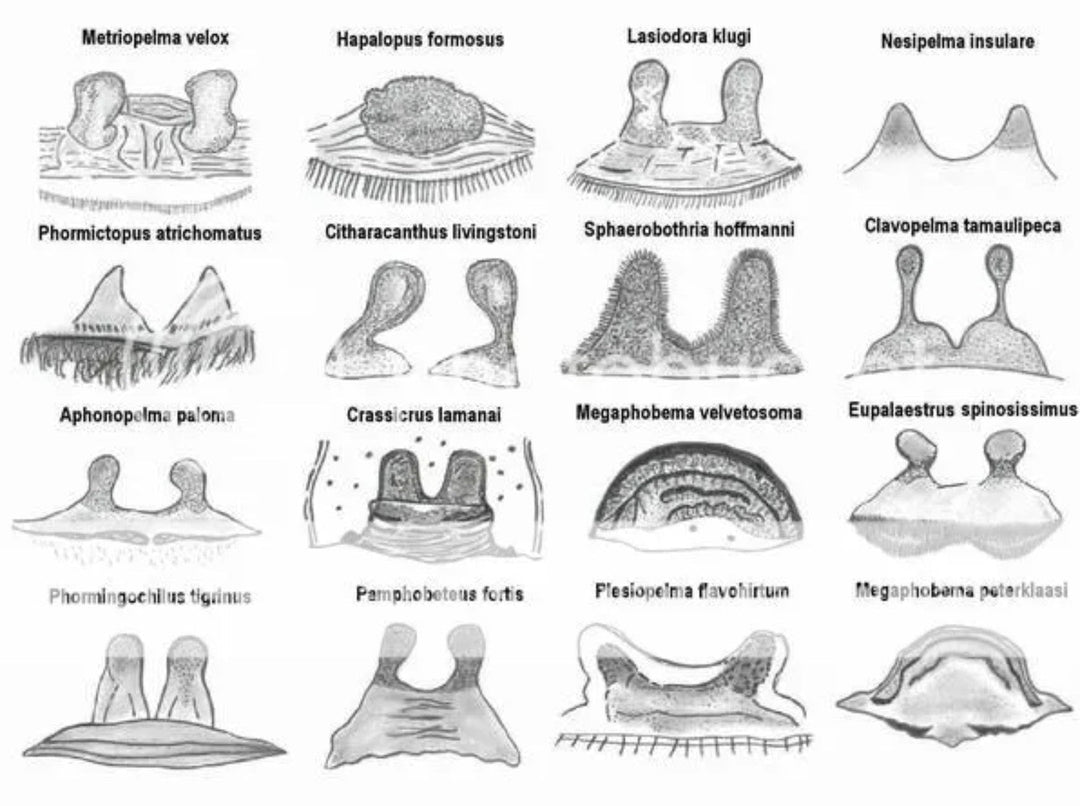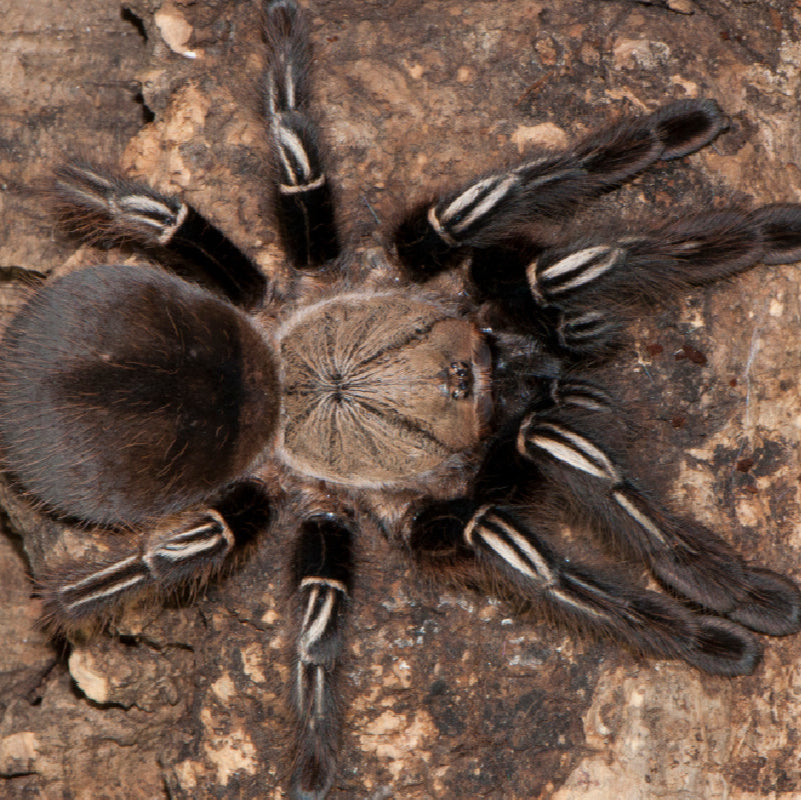Tarantula Basics
Tarantulas can be categorized in several ways. The following is a brief overview at some of the distinguishing characteristics in the world of tarantulas.
ARBOREAL
Simply put - arboreal means 'tree-dwelling'. In their natural habitat, these types of tarantulas can be found living in scrub brush, trees, in hollows, or between the leaves of bromeliad-type flora. Arboreal species are less robust than their ground-dwelling counterparts. This is due to their need for agility and protection from falls. These are suitable species for terrariums with live plants because it is unlikely they would attempt any reconstruction of their habitat. Vertically oriented enclosures are best - they ought be taller than they are wide. The typical recommendation is that the enclosure be 3-4x the size of the inhabitants diagonal leg span (DLS, how big is the spider).
Pseudoclamoris gigas (aka Orange Tree Spider) makes its home on a cork slab, and spends most of its time in a vertical position. It creates a retreat by mixing substrate in with its web, and hanging it vertically. We refer to these structures as 'dirt curtains'.
Arboreal tarantulas tend to like their humidity higher than terrestrial tarantulas. A good starting point when dealing with humidity is to make sure there is enough cross ventilation. Great ventilation mixed with a higher humidity does not lead to growth of mold. On the other hand, with improper ventilation and a higher humidity, your tarantula’s home will become a breeding ground for molds. Remember, you can always add more water to promote a healthier humidity for your tarantula. It is much more difficult to get excess water out of an enclosure with a stressed-out teleporting spider. Always have an appropriately sized water dish available and clean even if you have sufficient humidity. Most tarantulas are happy with ambient room temperature. If you are comfortable, they most likely are.
Species that enjoy their time in trees also like to have a place to go in the lowland. Provide a deep enough substrate for your arboreal to burrow if it so chooses. Here at Spider Shoppe we use, and recommend, Hunter’s Premium Substrate Mix with some of our Premium Sphagnum Moss. For small arboreal spiders, we offer the Spider Haus enclosure that ensures the proper amount of ventilation. If you want a large show-stopping display for your arboreal, check out our Acrylic Ventilated Enclosures.
Cork bark slabs and cork bark rounds make perfect hides and climbing structures for your arboreal tarantula. Arboreal species will also benefit from plants (fake or live). When using live and artificial plants, make sure they are free of all chemicals and that all enclosure decor is firmly placed as not to move and harm your tarantula.
Whether you feed roaches, crickets, or mealworms, your arboreal tarantula will likely enjoy their food dropped on their upper web canopy. For this specified task we use our 12” Straight Tongs and 12” Curved Tongs.
*This is a generalized care sheet for arboreal tarantulas. Please be responsible and research your specific species for more precise care. As always, if you have any questions contact us here.
Terrestrial
'Terra' is latin for earth, and synonyms for the word (terrestrial) include earthbound and earthly. It is not surprising that these tarantulas are referred to in this way. Terrestrial species don't like heights! In fact, falling poses a threat of rupturing their large abdomens. It is advised not to leave much height in terrestrial's enclosures. Filling enclosures high enough with substrate will save your spider from an injurious fall. These spiders include some of the largest in the world - Lasiodora, Xenesthis, and Theraphosa. Also included in this classification are some of the best new-keeper species such as those from the Grammastola genus.
Pamphobeteus sp 'Machala' is considered a terrestrial species. In the wild, they make their homes in hollows or other forms of shelter. In captivity - they spend much of their time happily on the surface and in view. However, in preparation for a molt, they do seem to prefer to burrow themselves in. This is for their protection during their vulnerable process of molting.
Nearly all terrestrial species employ use of hides or burrows at times. Some can be referred to as opportunistic burrowers - they'll use a hide sometimes if offered but do not require it. These species are highly adpatable to shallow burrows or hides, but spend a lot of time out in the open. For the well-being of your tarantula, we do advise offering a hide. This can be a cork slab or flat, and some use plastic flower pot halves. Then there are obligate burrowers. These species will often construct their own burrows by digging down into the substrate. However, unlike fossorials, these can adapt better to shallow burrows or hides. These also present on the surface more often than a fossorial species will.
Terrestrial tarantulas do not need as much humidity as arboreal species. However, terrestrial tarantulas always need an appropriately sized water dish. The substrate should be a mixture between dry and moist and comes down to what specific species you are housing. Often times, soaking one side or corner of the enclosure permits the spider to position themselves where the humidity is best for them.
When spiders burrow in their natural environment they are typically going into humid tunnels, so you do not want bone-dry substrate. Terrestrial tarantulas will use the extra humidity in the substrate to aid in molting. Here at Spider Shoppe we use, and recommend, the Hunter’s Premium Substrate Mix with some of our Premium Sphagnum Moss.
When selecting an enclosure for a terrestrial tarantula you will want a container with good ventilation, a secure lid, and enough horizontal space for a fair amount of our Hunter’s Premium Substrate Mix to allow for burrowing. Here at Spider Shoppe we use the Keeper Box in Small, Medium, and Large depending on size of spider.
Since terrestrial species do not like their eight-legs off the ground much, cork slabs and rounds need to be used as horizontal coverage. For smaller spiders, a cork slab can be cut to size and an “entrance” can be made using a rotary tool.
Terrestrial spiders will utilize plants (fake or live) to build great looking works of art with their web. The plants will also act as hides if the spider becomes startled. When using live and artificial plants, make sure they are free of all chemicals and that all enclosure decor is firmly placed as not to move and harm your tarantula.
Whether you feed roaches, crickets, or mealworms, your terrestrial tarantula will likely enjoy their food close to where are they so they can find it easily. For this specified task we use our 12” Straight Tongs and 12” Curved Tongs. Try to hold the prey as close to the bottom as possible so that your tarantula does not accidentally miss and hit the tongs with its fangs.
Fossorial
Fossorial comes from latin 'fossor' which means digger. These tarantulas live primarily, but not soley, underground. Keeping these spiders as pets requires unique housing. These tube dwellers will need ample vertical space and lots of substrate. It is always fascinating to witness these creatures reconstruct their enclosures. There are many Asian species which are known to live this way including Ornithoctonus aureotibialis (Thai Golden Fringe) and Cyriopagopus lividus (Cobalt Blue).

Cyriopagopus lividus (Cobalt Blue) is a strikingly beautiful blue-legged spider from Myanmar and Thailand. For some time, it was highly sought after and the only blue spider available to the hobby. It is often still wild-caught and sold cheaply in the US. Captive-bred animals are always preferred pets as they don't carry the same health risks as wild-caught specimens.
In housing fossorial spiders, we usually offer a small hide and a starter burrow. Depending on the size of the spider, we use a couple fingers or some other tool to create a recess into the substrate. The spider will tend to end up there, where it will continue digging down. One could adorn the enclosure with leaf litter, moss, or other decor if they wish. Eventually, the spider will dig to the bottom of the enclosure and create a den.
It is important with fossorial species to offer enough substrate. For a soft-rule, we suggest substrate be as deep as 2-4x the leg-span of the spider. This means that for a 4-5 inch adult C. lividus, we offer at minimum 10" substrate. There are many options available to fossorial keepers, including economical deli containers, mainstays gallon jars, and more. We have imitated taxonomist Volker Von Wirth's 'haplotank' style enclosure and offered it as part of our Spider Haus line of acrylics. This enclosure allows for bottom-soaking the substrate for a more natural humidity within the enclosure. See it HERE.
*This is a generalized care sheet for terrestrial tarantulas. Please be responsible and research your specific species for more precise care. As always, if you have any questions contact us here.
